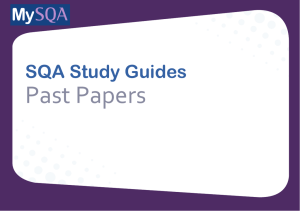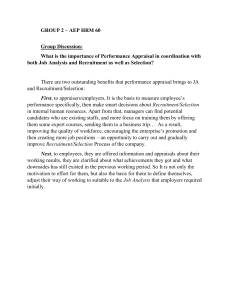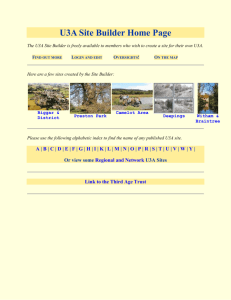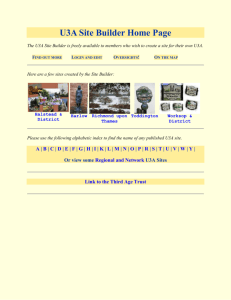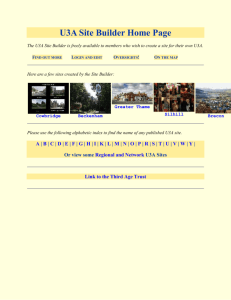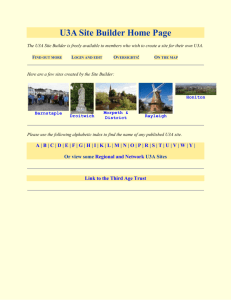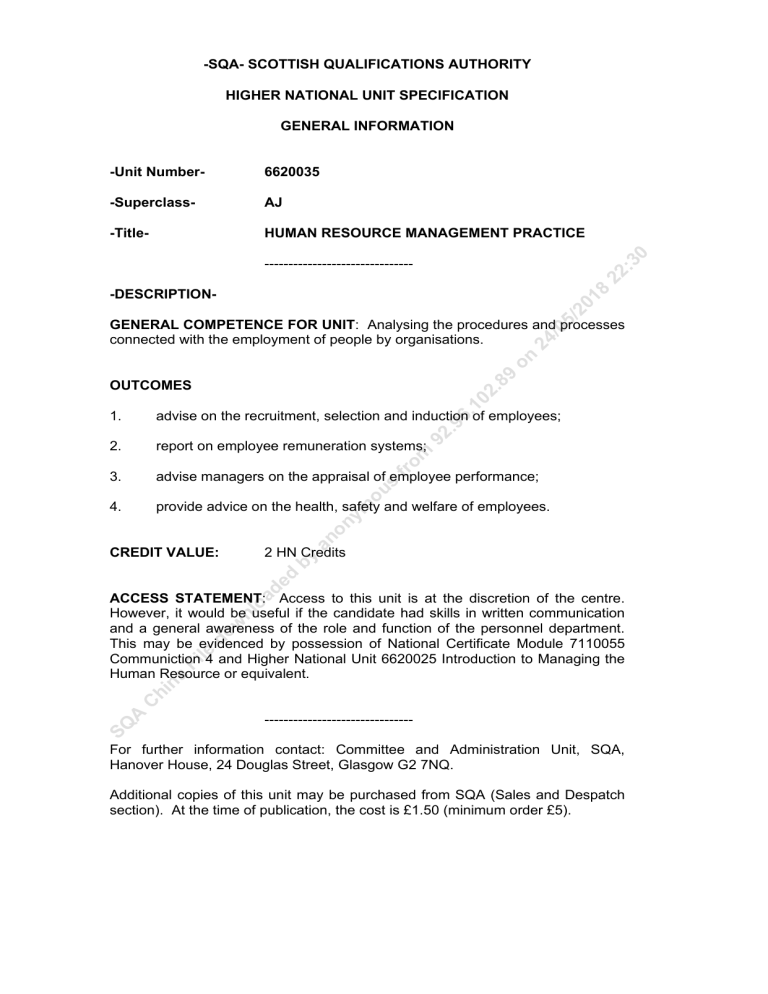
-SQA- SCOTTISH QUALIFICATIONS AUTHORITY HIGHER NATIONAL UNIT SPECIFICATION GENERAL INFORMATION 6620035 -Superclass- AJ -Title- HUMAN RESOURCE MANAGEMENT PRACTICE 22 :3 0 -Unit Number- 24 /0 5/ 20 18 -------------------------------DESCRIPTION- 89 on GENERAL COMPETENCE FOR UNIT: Analysing the procedures and processes connected with the employment of people by organisations. 10 2. OUTCOMES advise on the recruitment, selection and induction of employees; 2. report on employee remuneration systems; 3. advise managers on the appraisal of employee performance; 4. provide advice on the health, safety and welfare of employees. an on ym ou s fr om 92 .9 6. 1. 2 HN Credits de d by CREDIT VALUE: SQ A C hi na Fi le do w nl oa ACCESS STATEMENT: Access to this unit is at the discretion of the centre. However, it would be useful if the candidate had skills in written communication and a general awareness of the role and function of the personnel department. This may be evidenced by possession of National Certificate Module 7110055 Communiction 4 and Higher National Unit 6620025 Introduction to Managing the Human Resource or equivalent. ------------------------------- For further information contact: Committee and Administration Unit, SQA, Hanover House, 24 Douglas Street, Glasgow G2 7NQ. Additional copies of this unit may be purchased from SQA (Sales and Despatch section). At the time of publication, the cost is £1.50 (minimum order £5). Unit No. 6620035 Continuation HIGHER NATIONAL UNIT SPECIFICATION STATEMENT OF STANDARDS UNIT NUMBER: 6620035 UNIT TITLE: HUMAN RESOURCE MANAGEMENT PRACTICE 24 /0 5/ 20 18 22 :3 0 Acceptable performance in this unit will be the satisfactory achievement of the standards set out in this part of the specification. All sections of the statement of standards are mandatory and cannot be altered without reference to SQA. OUTCOME SELECTION AND on ADVISE ON THE RECRUITMENT, INDUCTION OF EMPLOYEES 2. 89 1. .9 6. 10 PERFORMANCE CRITERIA The advice is clear and precise and includes procedures for recruitment and selection consistent with accepted good practice. The advice is comprehensive and includes methods of job analysis and advertisement copy writing consistent with the requirements of the employer. The advice is comprehensive and includes recommendations for choosing recruitment sources and selection techniques appropriate to the requirements of the employer. The advice is complete and contains guidelines on the conduct of the selection interview which are consistent with accepted good practice and current legislation. The advice is thorough and contains techniques for the evaluation of the recruitment and selection procedure. The advice is thorough and contains procedures for successfully inducting new employees into the organisation. om 92 (a) ou s fr (b) an on ym (c) de d by (d) do w nl oa (e) hi na Fi le (f) A C RANGE STATEMENT SQ Recruitment and selection procedures: stages involved in recruitment and selection; roles of staff involved. Job analysis: job descriptions; personnel specifications. Recruitment sources: newspaper/journal advertising; recruitment agencies; job centres; educational establishments; executive search consultants. Selection techniques: interviews; psychometric testing; group selection methods; assessment centres; competence assessment. Evaluation: periodic performance reports; comparison between predicted and actual performance; examination of procedures. 2 Unit No. 6620035 Continuation EVIDENCE REQUIREMENTS Written statements with possible complementary oral questioning to ensure full coverage of the performance criteria and all classes within the range statement. Written evidence to include recruitment and selection flow chart, newspaper recruitment advertisement and induction checklist. 2. REPORT ON EMPLOYEE REMUNERATION SYSTEMS (a) 24 /0 5/ 20 18 PERFORMANCE CRITERIA 22 :3 0 OUTCOME The report is thorough and contains the objectives and constraints of the principal employee remuneration systems. The report is complete and contains the principal techniques for job evaluation consistent with the needs of the employer. The report is comprehensive and includes the advantages and disadvantages to the employer of the principal employee services and benefits. 89 on (b) om 92 .9 6. 10 2. (c) s fr RANGE STATEMENT an on ym ou Remuneration systems: timework; payment by results schemes; profit sharing; skill-based schemes; performance-related pay; harmonised/single status schemes. de d by Job evaluation schemes: non-analytical schemes; analytical schemes. do w nl oa EVIDENCE REQUIREMENTS SQ A C hi na Fi le Written statement with possible complementary oral questioning to ensure full coverage of the performance criteria and all classes within the range statement. 3 Unit No. 6620035 Continuation OUTCOME 3. ADVISE MANAGERS ON THE APPRAISAL OF EMPLOYEE PERFORMANCE PERFORMANCE CRITERIA (a) Managers and staff are advised on the principal objectives and constraints of employee appraisal systems. The operation of the principal forms of employee appraisal are accurately reported to the appraiser and appraisee. The roles of the individual involved in the appraisal processes are clearly defined and are consistent with the constraints of the system in use. Guidelines for the conduct of the appraisal interview are accurately reported to the individuals involved and are in terms of good practice. 22 :3 0 (b) 24 /0 5/ 20 18 (c) 89 on (d) 10 2. RANGE STATEMENT om 92 .9 6. The range for this outcome is fully expressed within the performance criteria. s fr EVIDENCE REQUIREMENTS on ym ou Written statement with possible complementary oral questioning to ensure full coverage of the performance criteria. de d by an Evidence for Performance Criterion (c) should cover at least four types of appraisal schemes. do w nl oa OUTCOME PROVIDE ADVICE ON THE HEALTH, SAFETY AND WELFARE OF EMPLOYEES hi na Fi le 4. SQ A C PERFORMANCE CRITERIA (a) (b) (c) (d) Employers and employees are correctly informed of their rights and responsibilities under current health and safety legislation. The principal causes of accidents are correctly reported to managers and staff. The costs and benefits of adopting ergonomic working practices are accurately reported to managers. Strategies for dealing with increased levels of stress in employees are accurately reported to managers. 4 Unit No. 6620035 Continuation RANGE STATEMENT Employers: direct employers; sub-contractors; co-contractors. Accident causation: preventable accidents; unforeseeable accidents. EVIDENCE REQUIREMENTS 22 :3 0 Written statements with possible complementary oral questioning to ensure full coverage of the performance criteria and all classes within the range statement. 24 /0 5/ 20 18 Evidence relating to Performance Criterion (d) should cover at least three different strategies. 2. 89 on MERIT Pass with merit may be awarded to candidates who have successfully achieved all outcomes and performance criteria and who, in so doing, consistently demonstrate superior performance with respect to one or more of the following: devising original/non-standard solutions to problems - eg, developing an innovative induction programme for new employees; demonstrating capability to work independently - eg, utilising a variety of non-standard sources for assessed work a candidate who uses only one standard text is unlikely to achieve merit); providing examples of best practice currently being used by employers in the area of human resource management; demonstrating clarity of expression and/or presentation by producing clear, precise and unambiguous documentation. .9 6. 10 (a) fr om 92 (b) ou s (c) an on ym (d) d by ----------------------------------- nl oa de ASSESSMENT C hi na Fi le do w In order to achieve this unit, candidates are required to present sufficient evidence that they have met all the performance criteria for each outcome within the range specified. Details of these requirements are given for each outcome. The assessment instruments used should follow the general guidance offered by the SQA assessment model and an integrative approach to assessment is encouraged. (See references at the end of support notes.) SQ A Accurate records should be made of the assessment instruments used showing how evidence is generated for each outcome and giving marking schemes and/or checklists, etc. Records of candidates' achievements should also be kept. These records will be required for external verification. 5 Unit No. 6620035 Continuation SPECIAL NEEDS Proposals to modify outcomes, range statements or agreed assessment arrangements should be discussed in the first place with the external verifier. Copyright SQA 1995 no profit is derived from the reproduction; if reproduced in part, the source is acknowledged. SQ A C hi na Fi le do w nl oa de d by an on ym ou s fr om 92 .9 6. 10 2. 89 on 24 /0 5/ 20 18 (i) (ii) 22 :3 0 Please note that this publication may be reproduced in whole or in part for educational purposes provided that: 6 Unit No. 6620035 Continuation HIGHER NATIONAL UNIT SPECIFICATION SUPPORT NOTES UNIT NUMBER: 6620035 UNIT TITLE: HUMAN RESOURCE MANAGEMENT PRACTICE 22 :3 0 SUPPORT NOTES: This part of the unit specification is offered as guidance. None of the sections of the support notes is mandatory. 89 on 24 /0 5/ 20 18 NOTIONAL DESIGN LENGTH: SQA allocates a notional design length to a unit on the basis of the time estimated for achievement of the stated standards by a candidate whose starting point is as described in the access statement. The notional design length for this unit is 80 hours. The use of notional design length for programme design and timetabling is advisory only. 92 .9 6. 10 2. CONTENT/CONTEXT This unit should be seen in the context of an employing organisation of 100 or more employees in any sector of employment, private or public. ou s fr om The unit concentrates on the procedures and processes connected with the employment of people by organisations. Emphasis should be placed on the changing nature of personnel management techniques. d by an on ym In addition, the pro-active, strategic role that the modern human resources specialist has to undertake should be contrasted with more traditional views of the department as re-active and advisory. The value added by the function should be stressed. nl oa de Corresponding to Outcomes: hi na Fi le do w Outcome 1: Advertisement copy writing can refer to a newspaper advertisement and cover display, semi-display and line format. Guidelines for selection interviewing could cover questioning techniques, pre-interview preparation and inter-personal perception issues. SQ A C Outcome 3: Appraisal schemes can include rating methods, comparison with objectives, critical incidents' narrative reports, behaviourally anchored rating scales, 360 degree appraisal. Outcome 4: Ergonomics could cover job design, equipment/material design, anatomy, physiology and psychology. Stress can include stress indices, sources of stress, impact on work environment and well as stress management programmes, relaxation techniques, counselling, changes in the work environment etc. APPROACHES TO GENERATING EVIDENCE Candidates should be encouraged to make use of their own experience, particularly any work experience which involved contact with the personnel department. Failing this candidates should be encouraged to make use of the wide range of academic and professional literature available. 7 Unit No. 6620035 Continuation Reference to current personnel management issues is to be encouraged and the use of case study materials to compare practices could be used to justify recommended strategies and procedures. ASSESSMENT PROCEDURES This is at the discretion of the centre. Clear and comprehensive procedures should be in place and efforts should be made to incorporate a variety of assessment techniques such as written reports, projects, oral presentations, role plays and case studies. Where cross unit/outcome assessment opportunities exist these should be used. 24 /0 5/ 20 18 22 :3 0 Efforts should be made to ensure the originality, authenticity and currency of the assessed work. REFERENCES Guide to unit writing. For a fuller discussion on assessment issues, please refer to SQA's Guide to Assessment. Information for centres on SQA's operating procedures is contained in SQA's Guide to Procedures. For details of other SQA publications, please consult SQA's publications list. 89 on 1. 2. 10 2. 3. fr om 92 .9 6. 4. ou s Copyright SQA 1995 an on ym Please note that this publication may be reproduced in whole or in part for educational purposes provided that: no profit is derived from the reproduction; if reproduced in part, the source is acknowledged. SQ A C hi na Fi le do w nl oa de d by (i) (ii) 8
